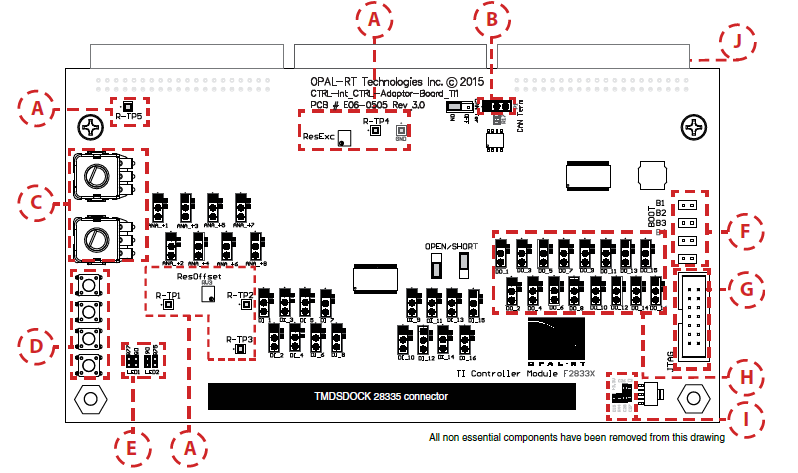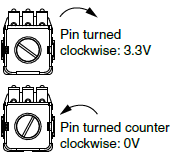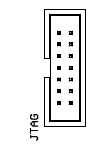Documentation Home Page ◇ Hardware Home Page
Pour la documentation en FRANÇAIS, utilisez l'outil de traduction de votre navigateur Chrome, Edge ou Safari. Voir un exemple.
OP8665 Controller Board Description
Controller Board Overview
The controller board holds the Texas Instrument DSP module via a 100-pin DIMM interface. It also offers a number of features designed to make using the OP8665 easier and more flexible.
It allows users to scale 0-16V to 0-3.3V. Analog inputs are scaled using the scaling factor Vo = Vi * ( 1 / 4.74 ), as in this example:
- Vi = 10V (From HIL)
- 10V * ( 1 / 4.74 ) = 2.1097V at the TI Controller
The controller board is powered by the controller interface (OP8665) via the 12V input power supply. It is connected to the interface board through three (3) 40-pin connectors.
Switches and potentiometers let users inject stimulus, a JTAG interface provides access for programming and debugging. The controller board also provides input protection.
| A | Resolver signal calibration potentiometers (3) |
|---|---|
| B | CAN Jumper, to connect or disconnect the CAN to DSP |
| C | Potentiometers, to select controller supply of either a 0V to 3.3V input |
| D | 4 push button switches to drive DSP input |
| E | LEDs displaying DSP output |
| F | BOOT selector jumpers. For OPAL-RT technicians’ use or by engineers familiar with TI controller programming. |
| G | JTAG connector for programming or debugging |
| H | 36 Jumpers for input/output control resolver signal calibration |
| I | Power LEDs |
ResOffset and ResExc labels are inverted in Version 2.x of 126-0505. Make sure to invert connections as necessary. Failure to do so may result in incorrect results obtained when operating the system.
Detailed Features Description
| A: Resolver Offset potentiometer | The Controller Board provides a Resolver circuit. The Resolver circuit can be calibrated via two potentiometers and the signals can be probed via test points. RV3: used to adjust the Resolver SIN and COS signal offsets. The offset voltage can be measured by probing R-TP1. In general, offset should be adjusted to in-between signal to avoid clipping at the output. R-TP1: used to adjust 0.5-3.3V (adjustment in RV3 provides 1.5V on R-TP1). R-TP2: used to probe SIN offset value. Amplitude measured at R-TP2 should be between 0.1V and 2.3V for correct operation. R-TP3: used to probe COS offset value. Amplitude measured at R-TP3 should be between 0.1V and 2.3V for correct operation. | |||||||||||||||||||||||||||||||||
|---|---|---|---|---|---|---|---|---|---|---|---|---|---|---|---|---|---|---|---|---|---|---|---|---|---|---|---|---|---|---|---|---|---|---|
| A: Resolver Excitation calibration potentiometer | RV4: used to adjust the resolver excitation signal’s voltage amplitude. R-TP4 is used to probe the excitation signal output of the Resolver Circuit. Signal will saturate around ±5.5V | |||||||||||||||||||||||||||||||||
| B: CAN jumper settings | Users can add a 120 Ohm resistor simply by placing the CAN jumper in the ON position, as shown. | |||||||||||||||||||||||||||||||||
| C: Potentiometer settings | User potentiometers provide 0V to 3.3V output:
| |||||||||||||||||||||||||||||||||
| D: DSP switches | The user switches SW1 to SW4. These switches are Normally Open and pulled-up to 3.3V. Press and hold to obtain 0 V (release to return to 3.3 V).
| |||||||||||||||||||||||||||||||||
| E: DSP output display LEDs | Only ON when the voltage is at 0.
| |||||||||||||||||||||||||||||||||
| F: BOOT selector jumpers | Selector Jumpers: these jumpers are reserved for OPAL-RT technicians or engineers who are experienced with Texas Instruments controllers.
| |||||||||||||||||||||||||||||||||
| G: JTAG connector | Allows the user to debug/flash the TI controller.
| |||||||||||||||||||||||||||||||||
| H: Input/output jumpers | Jumpers allow users to insert a short or leave the circuit open, as needed. Each jumper controls a specific channel, identified at each jumper on the board (see image opposite). | |||||||||||||||||||||||||||||||||
| I: Power LEDs | Green when 3.3V power is functioning |
OPAL-RT TECHNOLOGIES, Inc. | 1751, rue Richardson, bureau 1060 | Montréal, Québec Canada H3K 1G6 | opal-rt.com | +1 514-935-2323
Follow OPAL-RT: LinkedIn | Facebook | YouTube | X/Twitter










